Voting Teams
Follow the instructions in the other Personal Instruction Manuals (PIMs) for
instructions and responsibilities:
• E3-2
Issuing Votes (all team staff)
• E3-1
Managing a Voting Place (team manager)
This PIM covers some specific needs for working in an voting team.
Be familiar with the contents and ask your Electorate Manager if you have any
questions.
Each voting team will consist of a Team Manager, who has overall responsibility
for the voting team, and issuing officers. Each team will be accompanied by
a Justice of the Peace (JP) when visiting care homes, but not prisons, Police
stations or Defence Force Bases.
Schedule and EM briefing
• The schedule of visits for the team will be organised by the Electorate
Manager (EM) or Logistics and Supplies Manager (LSM) and recorded on M40-
VTPLAN.
• All teams will have at least two people, including the Team Manager.
• You should receive a briefing from the Electorate Manager before the first day
of voting about the specific duties for your team.
• Ensure you comply with facility requirements such as wearing an ID tag and
security checks. Your EM or LSM will provide you with more details on what
will be required and if there are any known hazards that you need to be made
aware of.
Your role
Your role in a voting team is very different from other staff issuing votes in voting
places because:
• You will be a visitor when you are issuing votes
• While staff at the facility are likely to assist you, their main priority is the
service they are providing (for example, caring for patients)
• Voters at care homes are likely to be in a private space such as a bedroom or a
ward, so be mindful of this and act appropriately
• Voters may have a medical condition and/or be receiving treatment at the time
you are issuing votes.
Allow up to 15 minutes for issuing each vote and some extra time to move from
one voter to the next.
3
The voter's experience
Every person has the right to cast their vote in a way which respects their privacy
and provides them with the freedom to make their own decision. You should be
supportive to all voters. Every effort must be made to ensure the secrecy of their
vote.
All staff should be sensitive to any special needs the voter may have because of
their age, language or disability. For example voters with intellectual disabilities
have the right to vote and should be supported as required, although they may
have a support person with them.
Your EM or LSM should have checked with care home staff about the best times
to issue votes to residents and whether there are any requirements you should be
aware of.
For example consider whether patients can move without assistance.
Offer help where needed and ensure voters feel respected – ask yourself how you
would like to be treated.
During voting
• You may need the help of facility staff to determine whether a person wishes
to vote or whether a person requires assistance to vote. Keep in contact with
facility staff during voting
• If a voter needs assistance to vote, they can choose who helps them.
For example they may choose a facility staff member, a family member if
present, or the JP accompanying the team
• If a voter wishes to make a vote, then it is your role to enable that and to
make every effort to ensure the voter's privacy and the secrecy of their vote
is maintained
• To assist voters with enrolment forms or special vote declarations in care
homes, you may wish to ask staff for the correct mailing address
• Keep an eye on the ballot boxes. Voters must place their ballot paper in the
ballot box; they are not permitted to keep them if they change their mind
about voting
• When moving between facilities, ensure that voting materials are not left
unattended at any time, including in cars.
4
Prisons
The LSM will contact prison managers to organise prison voting. An estimate of
the number of eligible prisoners will be provided to the Team Manager prior to the
voting team conducting any prison visits.
Security requirements
The LSM will advise the voting team about security requirements such as ID tags,
security checks, prison procedures and safety guidelines. They will also maintain
contact with prison management and resolve any issues as they arise.
Prison management should provide you with a secure room with tables and chairs
for voting. Do not issue votes in an open prison area - ask for a secure room if one
is not provided.
Vote issuing
You will issue votes to prisoners being held on remand or who are sentenced to
less than 3 years in prison. If a prisoner is not enrolled and wants to vote, issue
the prisoner with a special vote and ask them to complete an enrolment form.
Make sure that the prisoner provides their residential address prior to going to
prison on the enrolment form - not the prison address.
Prisoners in police cells
The LSM will contact Police station management to organise how Police cell
voting will be conducted. Arrangements will be made for the voting team to visit
Police stations before 12pm on Election Day. This will ensure any prisoners held in
Police cells on Election Day are given a reasonable opportunity to vote.
These will all need to be issued as Special Votes and returned to electorate
headquarters before 7pm on Election Day.
Personal safety
Voting teams experience a wide range of situations. If at any stage during your
duties you feel uneasy about a situation or environment, issuing officers should
talk with your Team Manager and the Manager should contact the Electorate
Manager as soon as possible.
As you move through the facility be aware of any hazards such as electrical cords
in working spaces, or wet floors if it has been raining.
Make sure the Electorate Manager is able to contact the Team Manager at any
time using the mobile phone assigned to your team, other than at facilities where
mobile phones are not permitted, such as prisons.
5
M Before leaving home
Check that you have:
Enough time to get to the facility
Chosen clothes and shoes for comfort and that would not be considered
inappropriate or politically biased
Packed reading glasses and any medication (if required)
Packed any personal identification, such as photo id, required at the voting
location and are aware of any restricted items, such as mobile phones
Packed this and your other PIM(s)
When travelling to and from the facilities
The driver must:
Hold a current driver's licence, for the class of vehicle being driven
Assess hazards when driving, drive within the legal speed limits and drive
to the conditions
Wear a safety belt at all times (driver and passengers)
Comply with all traffic legislation and report any accidents or damage to
the Electorate Manager.
Note: Always have your Commission issued mobile phone with you and have it
switched on, with location enabled. Use Google Maps on the mobile phone if
required to help you navigate between locations. Ensure that you have the phone
numbers for electorate headquarters, the EM and LSM with you, preferably loaded
into the contacts of the phone.
Before voting begins
The facility contact must meet the team and provide a briefing, such as
explaining emergency, any hazards at the site, and the location of facilities
such as toilets
The Team Manager must provide the JP with their briefing (see next page)
All staff and the JP sign in on Form S - Staff and introduce themselves
All staff, but not the JP, have an electoral official vest to wear with their ID
card.
6
Justice of the Peace (JP)
The Justice of the Peace is an independent observer of the voting process who is
present to maintain the integrity of the electoral system.
JPs must follow the instructions of the Team Manager and any requirements of the
facility. They are not members of the issuing team and are not permitted to issue
votes or handle EasyVote cards.
JPs are not permitted to intervene if they see anything that is of concern to them,
but should report the matter to the Team Manager in a timely way.
Justices of the Peace can only assist a voter if asked by that voter to help.
If a JP acts outside what they are permitted to do, the Team Manager will:
• Ask the JP to refrain from what they are doing, reminding them that their role is
to oversee and observe the procedures but not to become involved in them
• If the JP continues to intervene, the Team Manager will contact the EM and
inform them of the situation.
Briefing for Justice of the Peace by the Team
M Manager
The Team Manager will provide JPs with the following briefing before the start of
vote issuing:
"My name is [say your name] and I am the Voting Team Manager today. If you
have any questions or concerns about what you observe during voting, please
let me know and I will assist you the best I can. If I cannot answer your question
or concern, I will put you in contact with my Electorate Manager.
To help me and my staff today, please follow the rules of what a JP can and
can't do.
• You are here as an independent observer of the voting process. You cannot
issue votes or intervene in the voting process
• A voter may choose to ask you to assist them with their vote. This is entirely
the voter's choice and they can also choose to receive help from a facility staff
member or a family member if they are present
• You must not blog or otherwise communicate via social media about what is
happening during voting."
Note: JPs are not required to complete a Declaration of Secrecy. They should have
their own name badge to wear at the facility.
7
M Briefing for staff by the Team Manager
Before voting starts every day
Take time every morning to brief and remind staff:
• When they will have their breaks: depending on the number of hours they are
working. This may include morning tea (10 minutes), lunch (30 minutes) and
afternoon tea (10 minutes)
• To switch off mobile phones and other devices while they are working. Mention
that you will have the voting team mobile phone switched on so that the
Electorate Manager can contact you at any time
• The priorities during voting:
Keep votes safe: watching the ballot boxes, packing up materials while on
breaks
Voters' details are private: only use the information for the purpose of
issuing votes
Maintain secrecy: no posting on social media about what is happening, no
photos taken by staff or voters during voting
• To look after the needs of voters
• To follow vote issuing processes and that accuracy is more important than
speed. Mention that you will be checking for this as they issue votes during
the day
• That the voter in front of them is their primary focus.
• Whether you will have access to eRoll on the mobile phone to check the
details of any voter as necessary.
Supplies
Ensure that spare voting materials are kept secure
When distributing satchels to issuing officers check that each contains the
relevant issuing point stamp, ballot papers, electoral rolls, declarations
and enrolment forms.
Provide two ballot paper pads or declaration packs to begin with.
Each satchel should have red and black pens, a ruler, black stickers, party
list (E15) for any voter wishing to view
Keep one pad of E2 special vote ballot papers as a master to photocopy
from if required.
Do not issue these papers
You will be provided with a Team Manager’s folder that contains all the
paperwork and forms you will need.
8
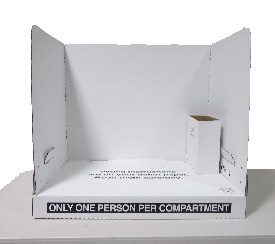
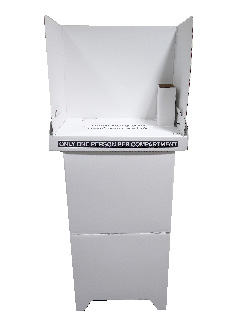


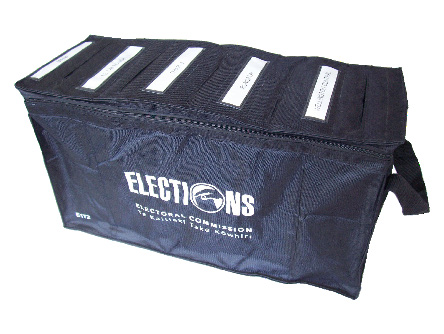
As appropriate for the facility instruct staff to:
Set up free-standing voting screens (E124) in groups of two, about one
metre from the wall, so the voter has their back to the wall
when voting
Set up table-top screen(s) and seating for elderly voters and voters with
disabilities
Set up your issuing desk using the instructions given in your E3-2 PIM
(page 30 & 31).
Instruct staff to set up the ballot boxes:
Check that the ballot boxes are empty
Seal the ballot box with a numbered seal and record the seal number on
the panel on the cardboard ballot box or on the form in the pocket of the
collapsible ballot box.
Note: If you are using a collapsible ballot box and it becomes full, the seal cannot
be broken before Election Day. In this case you will need to use a second ballot
box.
Leaving a facility
All materials must be packed up appropriately before leaving a facility. The ballot
boxes must remain sealed. When transporting materials by car, keep voting
materials out of sight, such as in the boot, and do not leave unattended at any
time.
You may be asked by members of the public about your role or what you are doing
with election materials outside of the voting place. Give a short polite answer
and provide the person with the Electorate Manager’s phone number if they are
insistent with their questioning.
For bedside voting, a mobile voting screen
(E127) may be used to provide privacy, or
the curtains around the bed if in a shared
room
Free standing voting
Top half of screen being
screen (E124)
used for table top voting
Collapsible
9
ballot box (E172)

eRoll:
• The mobile phone may be used by the Team Manager to look up the voter’s
details if you cannot determine which electorate they are enrolled in.
• It does not contain voters who are on the unpublished roll, as the details of
these people are not released publicly for privacy or safety reasons.
Only the Registrars of Electors have access to this information
• It is a live look-up so will show everyone who is enrolled to vote, including
those who have enrolled recently
• The mobile phone will not be permitted to be taken into prisons.
Dormant roll:
• If the Commission loses contact with a voter, for example a letter to a voter
cannot be delivered to them, the voter’s enrolment may be moved onto the
dormant roll.
This will appear in eRoll as:
• The voter can update their details using an enrolment form. They will also
need to cast a special vote.
• If voters of Māori descent are unsure which roll they were previously enrolled
on, call the enrolment helpdesk (0800 36 76 56) for advice.
10
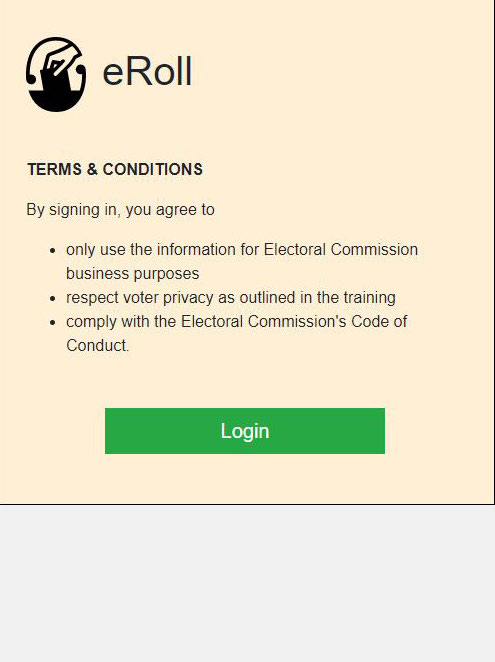


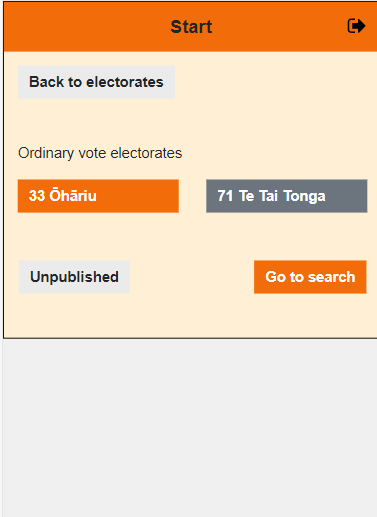



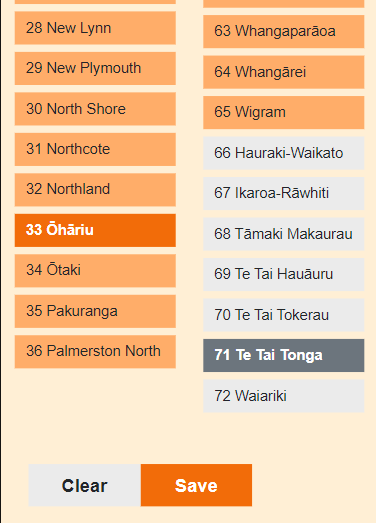
Using eRoll
1
Tap
Enter your user name
and password if prompted
2
Tap the electorates
your voting place is
issuing ordinary votes for
Tap
Note: tap a highlighted
electorate to unselect
3
Check the correct electorates
are listed.
Tap
11
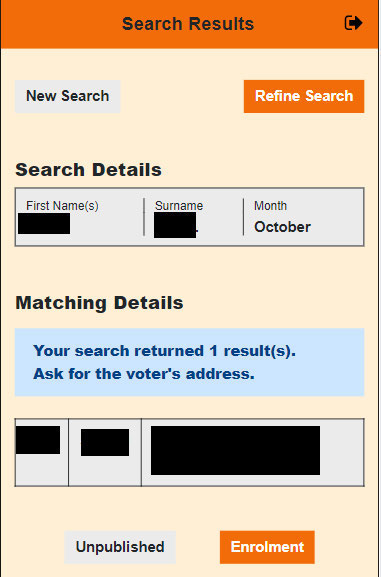


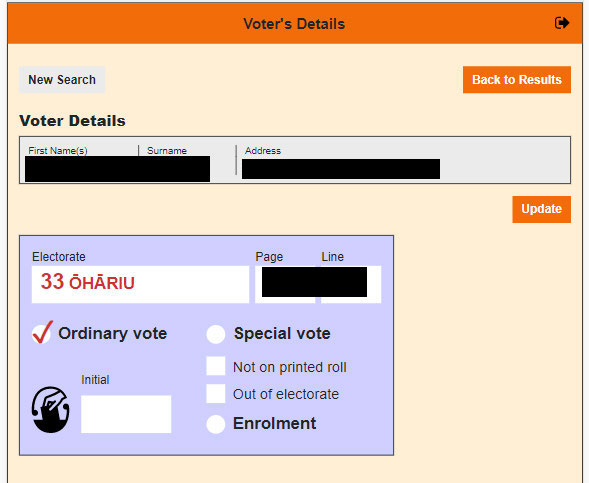

Using eRoll continued
4
Enter the voter’s details into the
search fields:
Only enter the first 4 letters and ‘.’
• First name(s)
• Last name (surname or family name)
• Select month of birth
Tap
All three fields need to contain
information.
5
eRoll will show a list of voters that
match the details you have entered.
Ask the voter their address and tap
the matching record.
Note: do not show the voter the details
on the mobile phone for privacy reasons.
6
Copy the information shown on
screen to a purple card and
give it to the voter.
Direct them to the correct queue
in the voting place.
Tap
12
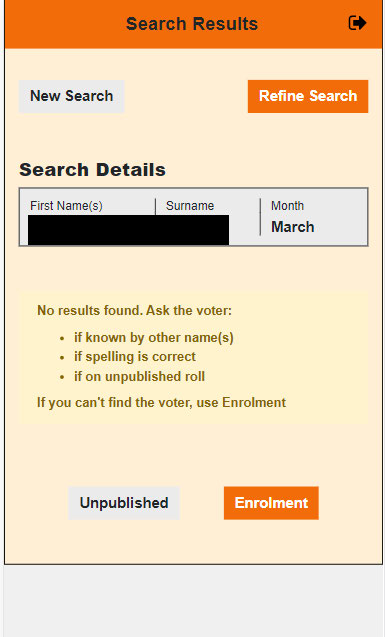


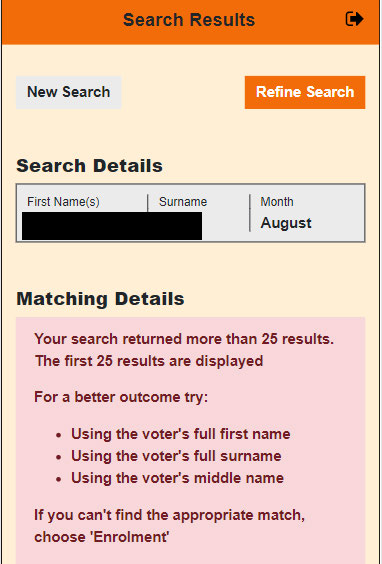



Using eRoll - troubleshooting
1
If there are no results that match the
voter’s details, ask the voter:
• if you have the correct spelling
• if they are known by
any other names
• if they could be on the
unpublished roll. If yes,
tap .
• if you still are unable to
find the voter, tap .
2
If the voter only has one name then
tap the
tick box
3
If there are more than 25 results from
a search, you will get a red warning
message above the results.
This could mean that the voter’s
details do not appear in this list.
Tap and add more
details to their name(s)
13
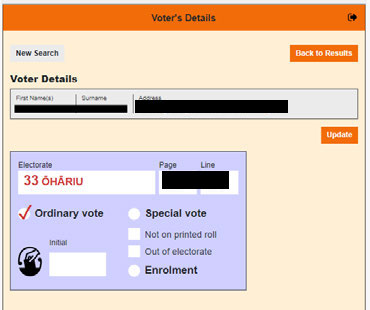

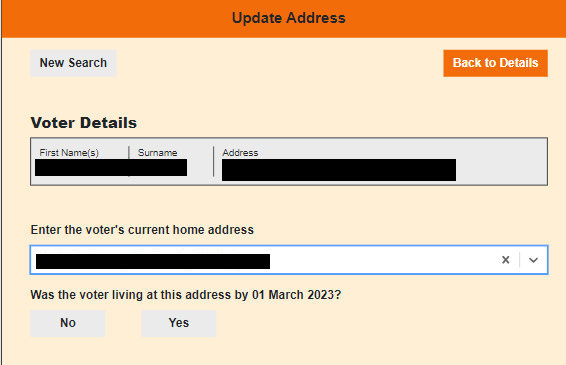


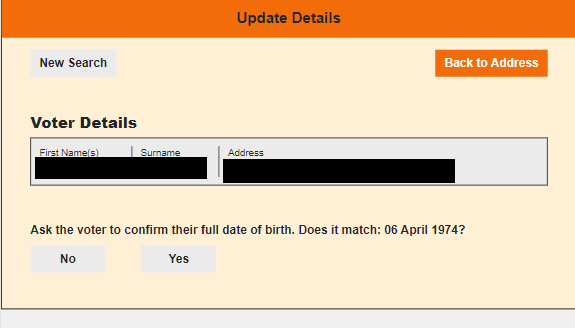


Using eRoll - update address
1
If a voter gives you a different address
from what is shown on screen you
may be able to use eRoll to update
their address.
Confirm that the address is a previous
address for the voter.
Then tap
2
Start typing the voter’s new address
and select from the drop down list.
If the address does not appear then
select “no matching address found”
at the bottom of the list.
3
Ask the voter if they have been
living at that address since
15 September this year
and tap
or
15 September 2023
4
Ask the voter to confirm their
full date of birth and tap
or
14
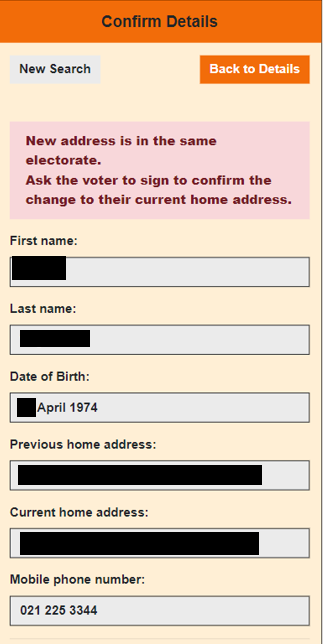



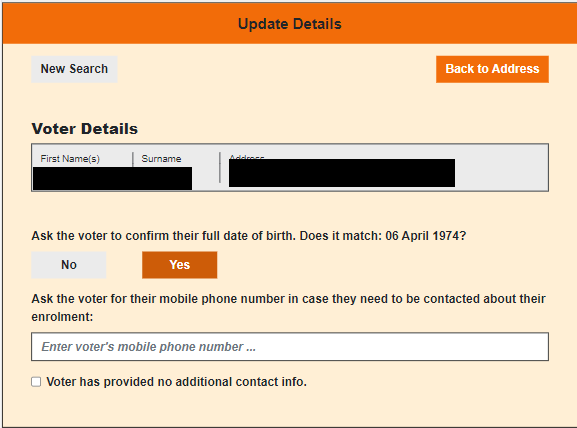
Using eRoll - update address
5
Ask the voter for their mobile
phone number.
Note: if the voter does not want
to give their phone number or
doesn’t have a mobile phone
select
6
Ask the voter to check their
details on the screen, read the
declaration and sign on the screen
Tap
15
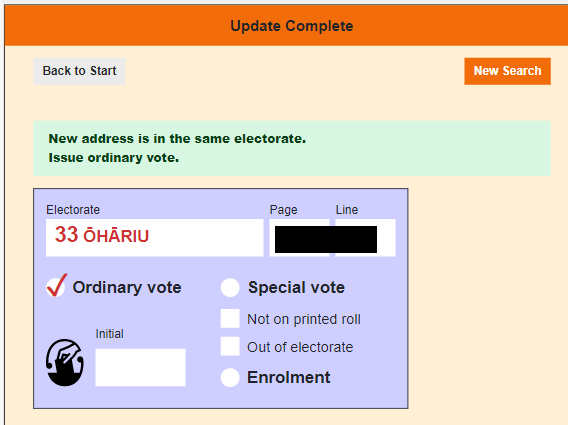

Using eRoll - update address
7 Copy the information shown on
screen to a purple card and
give it to the voter.
Then direct them to the queue
for ordinary votes.
Tap
Note: If the voter does not meet
the criteria to complete an
electronic update, the voter
can fill in a paper enrolment form
and receive a special vote
16
End of day processes
Follow the processes as given in your PIMs for the end of day processes, as in a
voting place. Issuing votes pages 34 - 35, Managing a Voting Place pages 27 - 41.
The key tasks are:
• All materials must be accounted for and reconciliation completed each day
that the voting team operates
• Use Form Q - Daily Report to record any details of the day's voting to discuss
with the EM or LSM
• Ask all staff and the JP to complete their timesheet on M37-VPTIME and sign
out on Form S, before leaving for the day
• If you are driving your own car, keep accurate records of your mileage to
record on a M38-EXPENSE claim form.
Delivering takeaway votes
The voting team may be called on if a person needs their vote delivered and/or
picked up.
You should:
• Work in pairs
• Wear your orange Electoral Official vest and name label, clearly identifying
yourself as an electoral official
• Record who you travelled with, the address(es) you visited and the time you
were at the address, on the M40-VTPLAN
17








































